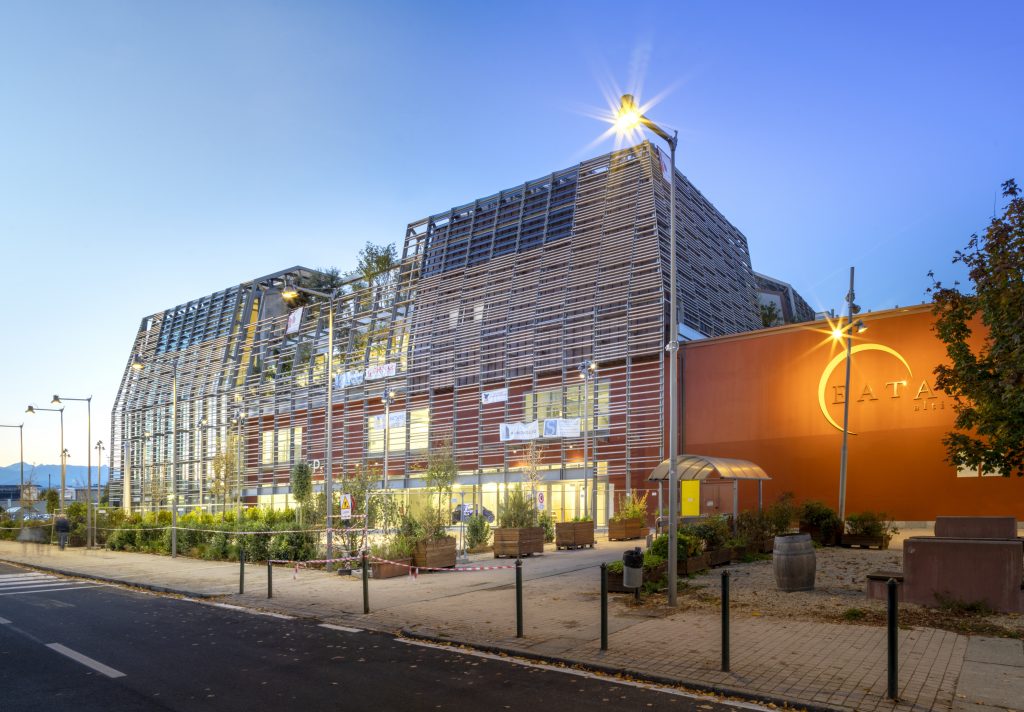
Photo © Fabio Oggero)
by Ron Bernthal
In early December, 2020, the former Torino Fiat Factory Lingotto, built between 1916 and 1923, opened to the public as a very eco-friendly retail market and unique architectural structure. The new business is called Green Pea.
Developed and sponsored by Oscar Farinetti, an Italian businessman, investor and owner of the high-end Italian food chain Eataly, the new transformed factory building is next door to Eataly Torino, which opened its first outlet in 2007 in, of course, the former Carpano vermouth factory. And not consequently, the Green Pea project was designed inside and out by Negozio Blu Architects (Ambrosini, Gatti, and Grometto) and the Torino design studio of Cristiana Catino ACC, the same team that designed the Torino Eataly shop next door.
Green Pea is one of the most interesting up and coming architectural projects in Torino, as this northern Italian city sheds its industrial past by following the trends of architectural innovation and sustainability that have resulted in such environmental and design friendly Torino buildings as 25 Verde, residential apartments where trees are rooted in terraces and lush gardens cover the roofs, and Renzo Piano’s Intesa Sanpaolo skyscraper where the top floors are taken over by a triple-height greenhouse, with views toward the snow-capped mountains that surround the city.

Cristiana Catino and Negozio Blu Architetti conceived a symbolic architectural plan to give shape to the strategic vision of Green Pea: create a highly sustainable building, and use the newest technologies and natural materials that convey, through architecture, the idea of ​​respect for the environment and harmony with nature. Commissioned by Eataly Real Estate, Green Pea is the final step in the redevelopment of the former Carpano Lingotto industrial area, an important project in the regeneration process going on in the southern area of ​​Torino.

Different natural environments start from the base of the building and meet in the large equipped garden roof, characterized by a bioclimatic greenhouse, that becomes the “fifth façade” of Green Pea.
Other greenery is inserted through the organic texture of the wooden façades, becoming part of the architecture. Vegetation also grows in the terraces where tall trees are planted in large tanks. The building appears as a natural organism that looks different according to the time of day and the growth of all the plants. The vegetation was selected to be suitable for the climate of the city, even taking into account the microclimate of the different façades and levels of the structure.

In this part of the city, heavily industrialized during the twentieth century, greenery is returning to play a central role in its new urban fabric. Plants, wood and glass have also created the pedestrian square at the foot of the building. The Green Pea building is fully sustainable and built using the most natural materials from local forests and workshops from the region.

Green Pea as a business is not alone in striving towards sustainable and eco-friendly perfection, but being a “retail store” with such a progressive environmental philosophy is quite unusual. With Green Pea, the basic concept that Eataly used to sell culinary products has been transferred to the furniture, clothing, giftware and cosmetics sectors, with the aim of changing purchasing habits. All products for sale are environmentally friendly and respectful of the environment: garments are made with fabrics derived from eco-friendly crops, cosmetics are organic, furnishings and furniture are produced without synthetic glues and built with materials that do not harm the environment. They are doing the same toys, ecological transport and many other products .
The project is aimed at ensuring total energy sustainability, both in terms of construction and management of the building during its commercial activities. The first floor displays clean energy vehicles using electric, solar, biomethane, and hydrogen; the second level offers ecological furniture; clothing made of natural fibers uses space on the third floor, with more clothes, a restaurant, bistro and bar on the fourth level. On top floor, called Ozio (idleness), there are no products for sale, just a small swimming pool, hanging gardens, photovoltaic daisies and wind turbines designed by Renzo Piano.

Torino has the only Green Pea outlet in Italy, but following Eataly’s similar business expansion plan, additional Green Pea’s are expected to open abroad in the next ten years, including London, Paris, the U.S., China, Japan, Canada and United Arab Emirates.

